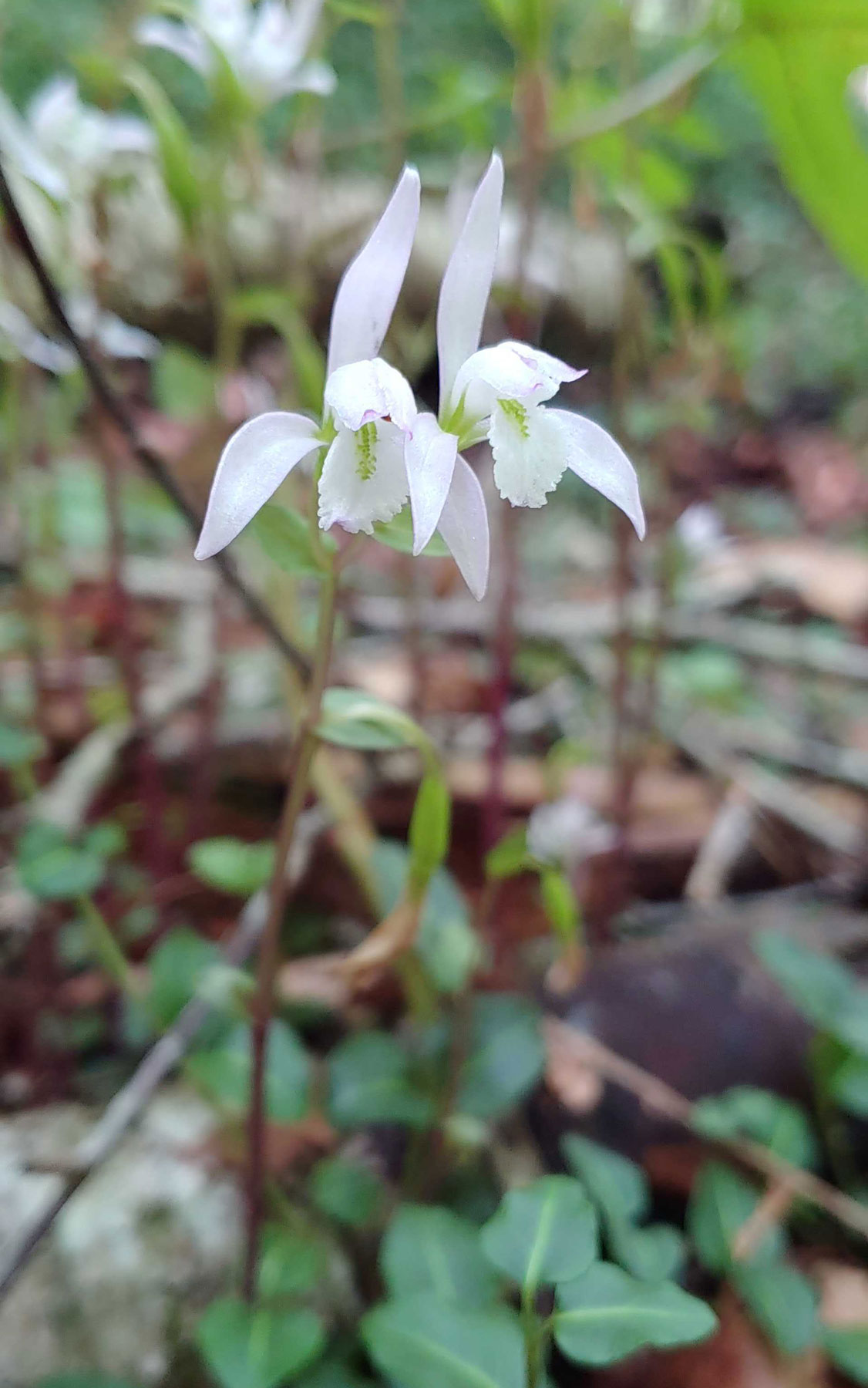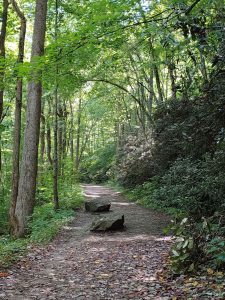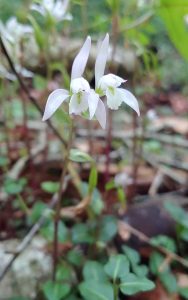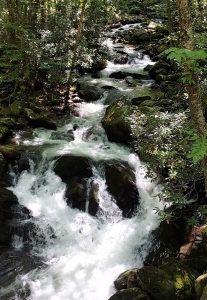
Close friends tell me my middle name should be “Serendipity” given my often-impeccable timing for wondrous happenstance. While I tend to chuckle when they say it, I can’t disagree.

As if on cue, of course, such happenstance struck yet again just before a recent late summer foray into the Smokies as part of my role as the GSMA Steve Kemp Writer in Residence for 2022. I had been intent on seeing what is known as “three birds orchid” (Triphora trianthophora) in bloom along a favorite trail near my home in Western North Carolina. While there was no way to know for sure, I suspected a daily barrage of torrential rain was keeping them in the droopy, wilted state I was witnessing.
Even under the most ideal circumstances, this somewhat rare, teeny-tiny orchid, whose winged bird-like flower typically blooms for a day, is notoriously hard to spot. I wandered the trail several days in a row, ultimately crying “Uncle” on my last visit since I felt certain they’d be gone by the time I returned home. Although disappointed, I was still grateful for having seen them bloom the year before.
Once in the Smokies, my attention shifted to cardinal flowers, which, unlike the three birds orchid, are hard to miss given their significant height and electrifying red hue. Knowing they bloom along stream banks, I decided to meander along the Middle Prong Trail to see if the cardinal flowers might be blooming, hopeful they would be accompanied by a slew of butterflies clamoring for a smackerel of pollen, a la my favorite, Winnie the Pooh.
Despite not seeing red, I was certainly not lacking for wonder. The Little River, quietly rippling and loudly roaring at alternating intervals, was a perfect companion, as were the leaf-lined tulip poplars, red and white oaks, and eastern hemlocks, generously providing soothing shade from the summer heat.
Mindful to stay hydrated, I stopped to pull out my water bottle and take a swig. A speck of white suddenly caught my attention.
Could it be?

I looked down, and not only did I see a single three birds orchid in bloom, but I also saw others blooming nearby. Careful to watch my step and avoid any inadvertent blossom squishing, I explored the immediate terrain, knowing in my bones there would be more. Oh, was I ever right.
Bubbling with excitement, I shared my newfound treasure with a few passersby, one of whom said the experience was the highlight of her hike, which, of course, made my day even better.
Something told me this patch wasn’t on the park’s radar. That’s when I shared my find with Jaimie Matzko of Discover Life in America (DLIA), a non-profit park partner I’d recently learned about as part of my residency. In a nutshell, DLIA works with park staff, researchers, and volunteers to study biodiversity in the Smokies. They are responsible for managing the All Taxa Biodiversity Inventory (ATBI), an ongoing effort to catalog every living species that exists in the park. Matzko, the organization’s biodiversity program specialist, coordinates the volunteer and education programs. She was fairly certain my three birds orchid assumption was correct.
What made my find even more exciting was that it appeared on the Smokies Most Wanted list, a DLIA initiative that encourages park wanderers like me to record our discoveries using iNaturalist. Every discovery matters according to Will Kuhn, DLIA’s director of science and research. “We added the three birds orchid to Smokies Most Wanted because it’s rare and we don’t have too many datapoints,” he says.
Both Kuhn and Matzko wholeheartedly believe in the importance of community science where visitors like me can contribute to the park’s collective knowledge. “The more datapoints we have, the better we can predict where things can be found,” Matzko says. That data can also help guide park conservation decisions. Matzko likens the exploration to a science-based version of geocaching. She encouraged me to download iNaturalist on my phone so I could participate in the adventure.

As I write, there are more than one thousand species that have been discovered within the 522,427-acre park that have not yet been formally identified. In the past eleven years, according to Kuhn, the number of iNaturalist users in the park has exploded from four to more than 7,000. When I think of the 14 million annual visitors, a significant percentage of whom carry cameras or cell phones, it feels like the possibilities for myriad discoveries are vast.
Kuhn and Matzko encourage those who want to share their finds to both peruse the Smokies Most Wanted and make photo observations with the corresponding location on iNaturalist. “Everything uploaded to iNaturalist within the park goes into our ATBI project,” Matzko says. She notes that the simple act of posting a flower photo (preferably without insects) can help them anticipate when those flowers will bloom at varying locations and elevations.
“People don’t realize they’re not only learning for themselves, but helping us,” adds DLIA Executive Director Todd Witcher. “Part of our mission is also to stimulate and excite the next generation of scientists.”
I admit, having made that one contribution and having been inspired by my conversation with Witcher and Matzko, I’m feeling like Veruka Salt from Willy Wonka and The Chocolate Factory. I want more and I want it now! Who knows? With serendipity on my side, anything is possible.
Subscribe to get the latest posts sent to your email.
The Great Smokies Welcome Center is located on U.S. 321 in Townsend, TN, 2 miles from the west entrance to Great Smoky Mountains National Park. Visitors can get information about things to see and do in and around the national park and shop from a wide selection of books, gifts, and other Smokies merchandise. Daily, weekly, and annual parking tags for the national park are also available.